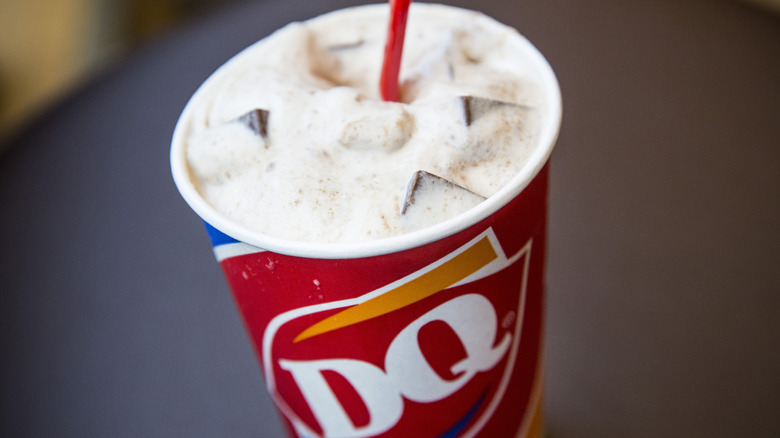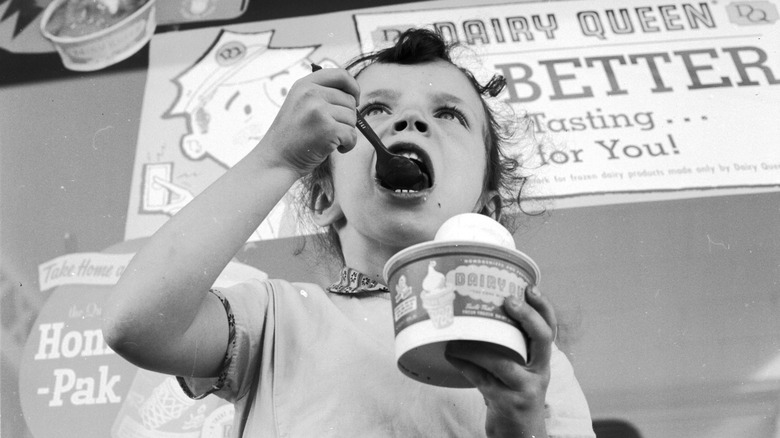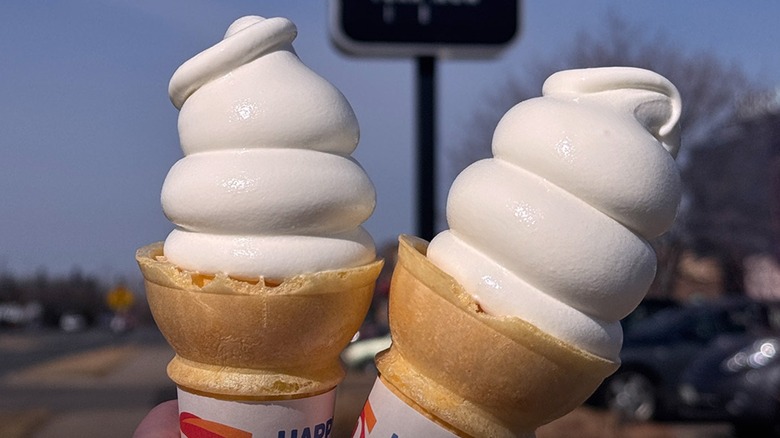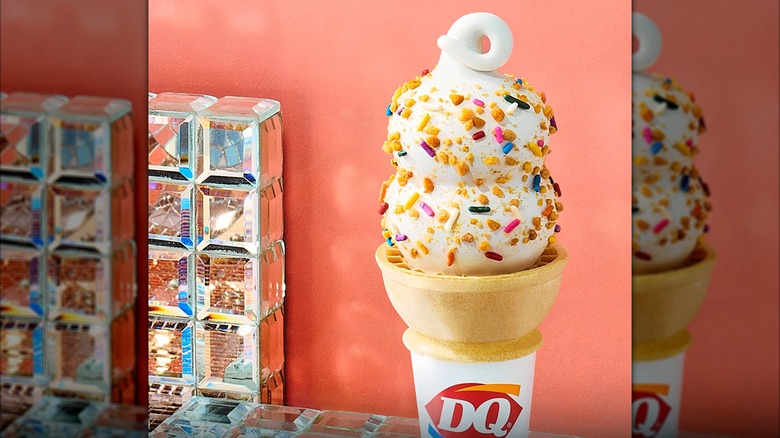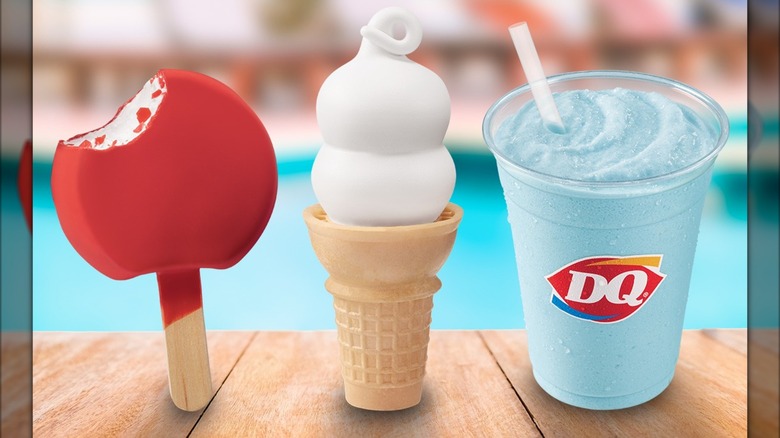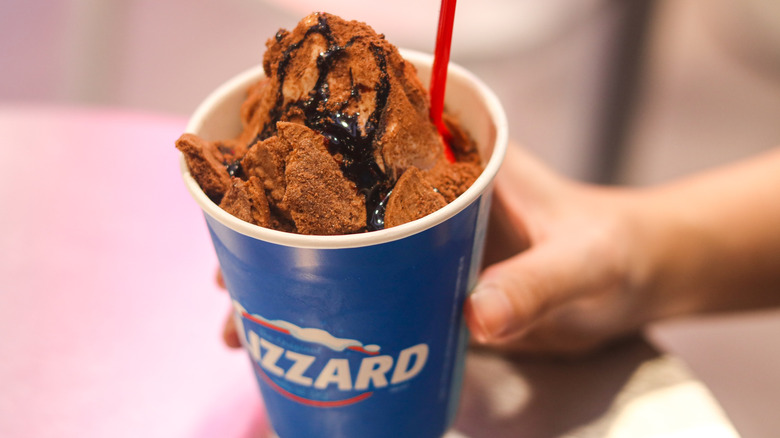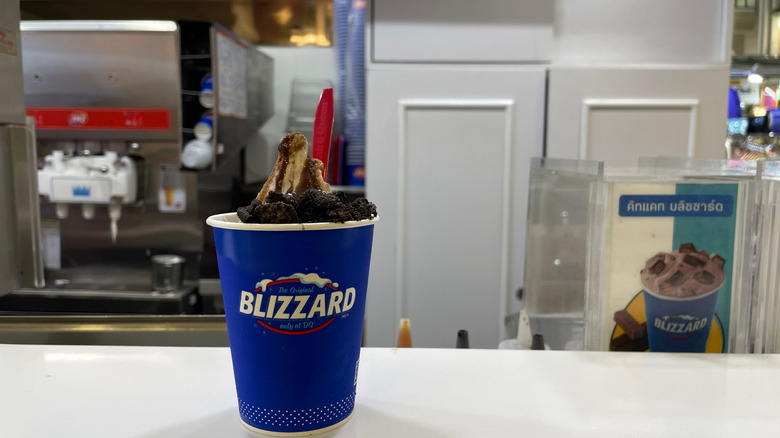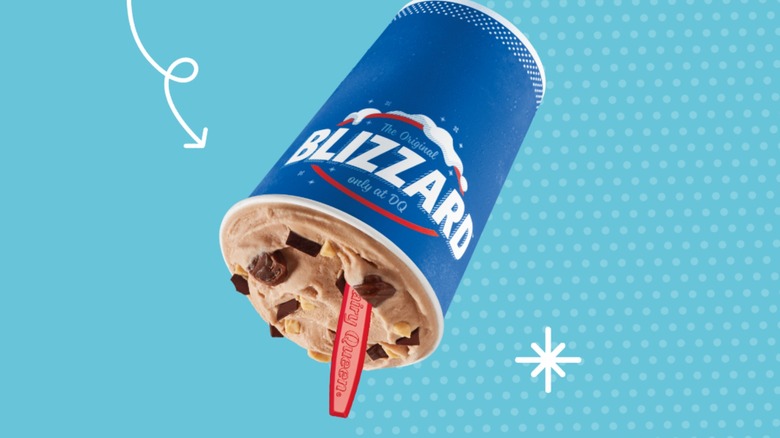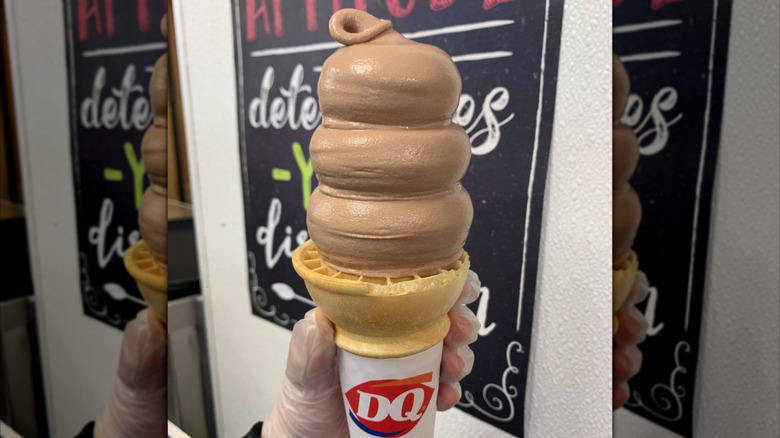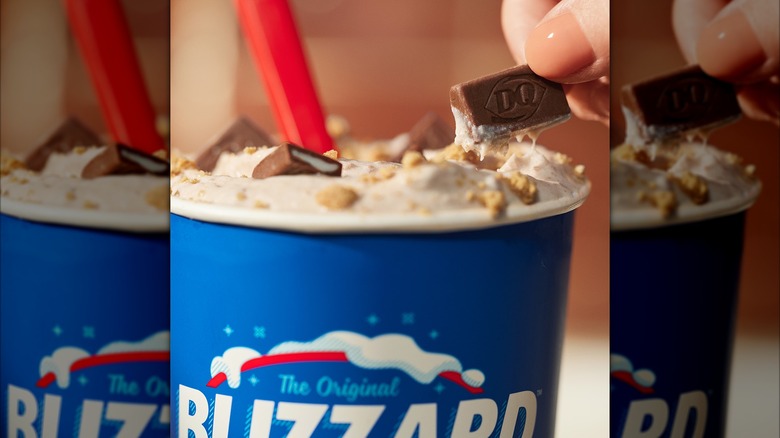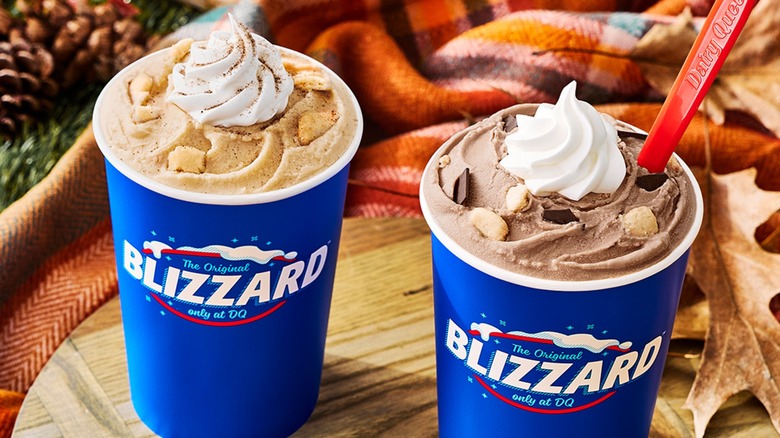All Your Dairy Queen Ice Cream Questions Answered
It takes a lot for a fast food place to stand out from a pack that all seems to be serving up a variation on the burger-and-fries game, but Dairy Queen has always done so in a big way. That's largely thanks to its ice cream ... but hold up. It's not actually ice cream, is it? It's technically called soft serve, and it's been that way for so long, you might not even give it a second thought.
We'd argue that you absolutely should question this, though, because it's possible to argue that without soft serve, Dairy Queen wouldn't be the powerhouse that it is today. Not questioning it is to overlook years and years of research and development that went not only into a single soft serve recipe, but into the creation of bespoke soft serve machines and a slew of products that came afterward.
It wasn't always smooth sailing, either. Did you know that Dairy Queen employees originally had to crush a lot of the candy mix-ins for Blizzards by hand? That's some serious devotion. We wanted to learn more about the chain's famous soft serve and some of the secrets behind it. We reached out to Dairy Queen with a handful of questions to see what we could learn, and we also did a deep dive into the chain's history to see what's changed and what's stayed the same. Finally, we got insight from Redditors willing to share some secrets, and here's what we found out.
How was DQ's soft serve created?
Sometimes, our favorite food and drinks happen by accident. Champagne was an accidental invention that dates back to the 17th century, and much more recently, popsicles were the result of another happy accident. Dairy Queen's soft serve, however, was the result of years of hard work, experimentation, and struggles. The story — as explained by documentation from DQ — began in the 1920s, when John Fremont "Grandpa" McCullough and his son, Alex McCullough, founded an ice cream company. By the 1930s, they were working on the idea of creating a machine that could dispense a softer version of ice cream on demand, which took years of trial and error and a few not-so-perfect prototypes.
Early machines made ice cream, sure, but required shoveling ingredients into the top, then using a carefully positioned mirror to see if the consistency was right. That was not super viable for long-term and widespread use, and the machine went through several different incarnations before being built to specifications, ordered, and shipped to fledgling stores back in 1940. Who knew soft serve was such a complicated process?
Alongside the invention of the machine, "Grandpa" McCulllough is credited with giving the final approval to the first soft serve recipe. Along with that came some neat findings: The perfect formula had a butterfat percentage that hovered between 5% and 6%, and when the temperature of the mixture was lowered to 18 degrees Fahrenheit, it formed a soft, shapeable cream.
How was the original ice cream different from today's?
When something is plain or boring, it's often said to be vanilla. Vanilla might have an underwhelming reputation, but we'd argue that it's popular for a reason: It's just as magical as back when it was a rare commodity. Dairy Queen's flagship soft serve is, of course, vanilla, which makes it an ideal backdrop for pairing with any number of flavors. Interesting, though, is exactly where that vanilla came from: It was specially designed and formulated for Dairy Queen, and it's been the exact same for decades.
Buried in the literature DQ sent us is a tiny tidbit about who created the proprietary vanilla formula the chain started using in 1946, and still uses today. His name was Jake Beck, and although the Beck Vanilla Company has since become Firmenich, it's the same flavor that was enjoyed by returning World War II veterans, 1950s-era housewives and their families, the flower children of the 1960s, the most cynical of GenX kids, and by us today. Neat, right?
There were a few other interesting people we can thank for DQ's enduring popularity. Early stores bought milkshake machines and other equipment from none other than the famous — and perhaps, infamous — McDonald's head Ray Kroc. Kroc would later say he was inspired by DQ's franchise system, which was largely developed by the same man who engineered the soft serve machines — Alex McCullough.
Where did the trademark curl come from, and how was it developed?
Another feature that's been around for a very long time is that trademark curl on the top of all of Dairy Queen's soft serve cones. According to the company's history, that was initially something the machines did naturally when the flow of soft serve was stopped, and it was trademarked way back in 1953. The company has since continued to not only renew the trademark — officially called "The Cone with the Curl on Top" — but to teach all new employees how to make the curl. It's reportedly harder than it looks, too, with new employees sometimes needing to make a few hundred cones before they get that distinctive bubble shape and twirl just right. If at first you don't succeed, try, try, try, and then try again!
It's also worth noting that Dairy Queen takes its intellectual property very, very seriously, and much of it was developed by an early store owner turned DQ operational guru named Sherb Noble. Noble owned a number of stores and is largely credited for raising the company's profile with an early all-you-can-eat ice cream deal. Things have moved on since then, but DQ is still fiercely protective. In 2022, it lost a lawsuit over the name "Blizzard," when it claimed a spring water company couldn't use it because of product confusion. The suit was settled in favor of the then 11-year-old water brand.
Why is it called soft serve instead of ice cream?
Dairy Queen is a little unusual in that it doesn't proclaim to sell ice cream ... not precisely, at least. You're ordering soft serve, and if you've ever wondered why, you're not alone. According to some Dairy Queen histories, the idea of soft serve came about in an attempt to serve the freshest, most recently-frozen ice cream possible. That worked best when there was about half of the typical butterfat content that was found in most ice creams, resulting in a softer serve.
Really though, it's all down to a technicality. For a long time, guidelines established by the Food and Drug Administration ruled that all ice cream had to have a certain amount of milk or butterfat. Since DQ's recipe contained only between 5% and 6%, that put it at about half of the FDA's 10% requirement for the ice cream label. DQ's recipe was officially designated as ice milk, but way back in 1994, the FDA got rid of those guidelines.
The bottom line is that yes, Dairy Queen can now say it's serving ice cream. It's considered part of the low-fat ice cream category, but honestly, we understand why the chain has stuck with soft serve. It's been an iconic term and designation all these years, so why ruin a good thing? And in case you're curious, Dairy Queen confirmed that the same recipe is used to make the soft serve cones, sundaes, and Blizzards.
How much ice cream does Dairy Queen make/sell in a year?
We'd love to know just how much soft serve gets made in a year, but unfortunately, Dairy Queen didn't share those numbers. We were privy to some historical tidbits though, including the fact that on a record-setting day in 1940, one of the first DQ stores took in $88. Adjusted for inflation, that's around $2,000 in 2024. Considering cones and sundaes would have cost pennies, that's a wild number of customers. That same season, the first store sold 2,170 gallons of soft serve mix.
In more recent history, Dairy Queen says that when the first Blizzards debuted in 1985, around 175 million were sold ... give or take. That brings us to an event in 2005 that can serve to give us an idea of just how much soft serve mix there is in 2,170 gallons. That's the year that one franchise owner decided to make the largest Blizzard ever, and did. The 22-foot-tall Blizzard included 700 gallons of soft serve.
But what does that look like on an individual store level? Numbers are hard to come by, but we can tell you that in 2022, the Dairy Queen in Manchester, New Hampshire, set the annual record for doing the most business. The store was about $3,000 ahead of the second-place store in Gray, Georgia, which is wildly impressive. According to reports, DQ is hoping to pass $10 billion in annual sales by 2030.
How long does it take to clean those soft serve machines?
Ice cream connoisseurs have probably heard that soft serve machines can harbor all kinds of gross bacteria, and McDonald's out-of-commission soft serve machines are the stuff of legend and memes. We wanted to know, then, how Dairy Queen manages to keep those soft serve machines running in a way that has long seemed elusive to McDonald's. When we didn't get an answer from the company, we did a little sleuthing of our own.
Redditors, it turns out, had many of the same questions we did. Thankfully, other Redditors claiming to be DQ employees came to the rescue. Many of the answers were similar and suggest that machines are thoroughly cleaned every night at closing. One Redditor added that along with regular, daily cleaning, there is a deep-cleaning cycle scheduled to be done every 72 hours. The cycles are surprisingly quick and take only an hour or two.
We also found discussions about how the deep-cleaning process involves a complete disassembly, cleaning, and reassembly of the entire machine, and finally, they're rinsed thoroughly with water every morning before any soft serve goes through ... according to Reddit. There are, however, several different types of machines used by various DQ locations, so it's safe to assume that the specific procedures are not all the same. Surprisingly, some Redditors noted that several of the machine's parts, including the O-rings that seal joints, need to be replaced at least monthly.
What makes a Blizzard stay in the cup?
Dairy Queen lore says that the idea for the Blizzard goes all the way back to 1959, when an ice cream shop owner frustrated at a teen customer's request for a thicker and thicker milkshake finally flipped the cup over to demonstrate just how thick it was. That's reportedly what got translated into the current practice of serving Blizzards upside-down (which varies by location). But why does it work?
There's a little bit of neat science going on here. In addition to the lower butterfat content, Dairy Queen's soft serve also has air added into the mixture — something that doesn't happen in the process of making most ice creams. The air means that it's lighter than regular ice cream, but at the same time it takes up more space in the cup.
DQ's soft serve also contains a few other elements that all work together to create the perfect environment within that cup. When your candy or cookie pieces of choice are mixed in, that's not all that's getting mixed in — more air is going in too. Factor in emulsifiers like carrageenan and guar gum that are used to help ensure everything's mixed together, while also thickening, stabilizing, and increasing the viscosity of the soft serve. All of that together means your Blizzard isn't going anywhere until you scoop it out by the spoonful.
Why isn't chocolate soft serve available in every store?
If you're used to only seeing vanilla soft serve at your local DQ, there's nothing quite like the moment of realization that comes when you find out that some Dairy Queen stores have chocolate soft serve. When we asked for the official reasoning behind the lack of chocolate in all locations, DQ confirmed to us that it was a decision that was left up to individual franchisees.
When we couldn't pin down exactly how many locations sell chocolate, we headed to Reddit. One poll from 2022 suggested that the overwhelming majority of respondents did, in fact, have chocolate at their store. Some people noted that even though their store didn't sell chocolate soft serve, it was still available and used in cakes. Others said their stored used chocolate fudge and syrup to create the chocolate soft serve for their cakes. Meanwhile, some said that even though their store had chocolate, they estimated vanilla outsold chocolate about 10 to one. It makes sense, then, that vanilla remains the popular choice.
In case you're wondering why some stores might have toppings that others don't, we found an answer to that, too. One Redditor who identified themselves as a DQ manager clarified that even franchisees needed to buy approved products through the chain's distribution network. Some items — like chocolate sprinkles — are simply not an option for franchisees even if they wanted to carry them.
Why does the ice cream vary in thickness and density?
Here's another question that we turned to Reddit for, and after sifting through a number of replies from people claiming to be employees and owners of DQ stores, we think we've figured out what's going on with the consistency of the ice cream. If you think that sometimes it's thicker than other times and you're wondering why, it seems to have something to do with the machinery.
Management and employees alike discuss several different types of soft serve machines, and depending on what's at your local DQ, there are a few things that could be happening to alter the texture. One person suggests that some machines have settings that allow users to adjust components like airflow, which can change consistency. Others also confirm that consistency largely comes down to the amount of air that gets mixed into a batch of soft serve as it freezes. This is a balance that can get thrown off by factors like seals needing to be replaced. Also, when the machines are being heavily used, they can get sensitive and experience issues.
Still other comments suggest that if you're getting a super-fresh soft serve from a new bag of mix, it might come out less frozen than if it had been in the machine for longer. Finally, over-blending a Blizzard might add too much air to it, affecting the consistency. It's a delicate process!
How much R&D goes into new flavors and products?
There are a lot of discontinued Dairy Queen Blizzard flavors that we'll probably never get again, and that's a bummer. (We're looking at you, Salted Caramel Blondie Blizzard.) If you started naming all the Blizzards you'd ever tried, we'd guarantee you would miss some. That's because there's an almost shocking number of Blizzards that have been released: According to DQ's official count, there have been more than 170 different types and flavors of Blizzards on the menu. One of the most popular Blizzards isn't even available in the U.S., a delicious-sounding green tea sold in China.
We asked for a little insight into Dairy Queen's research and development process, and while it might seem like dreaming up new flavors and combinations would be a super fun job, it's pretty intense. There are multiple steps to the process, and every new flavor goes through various stages of development that can take anywhere from nine months to a whopping three years. That's some serious dedication.
